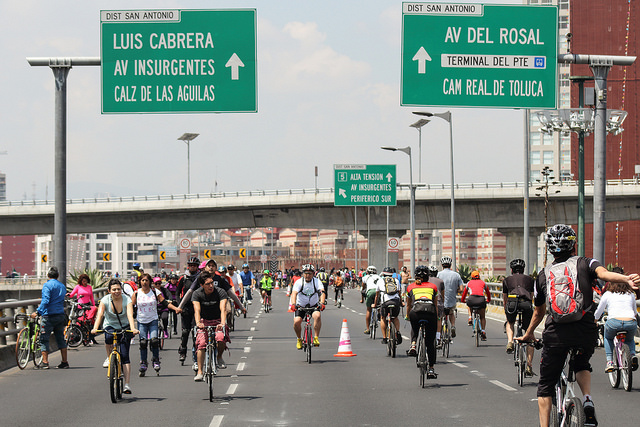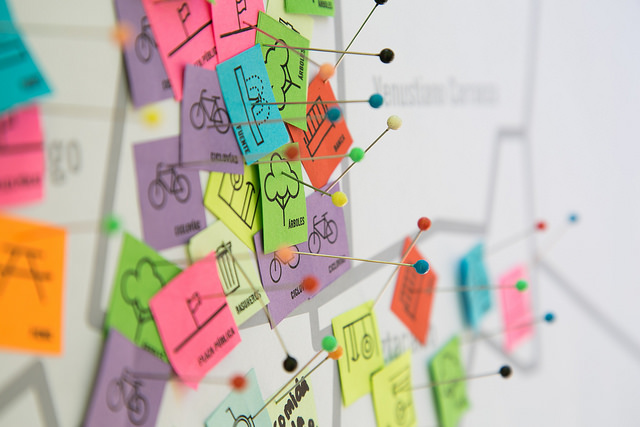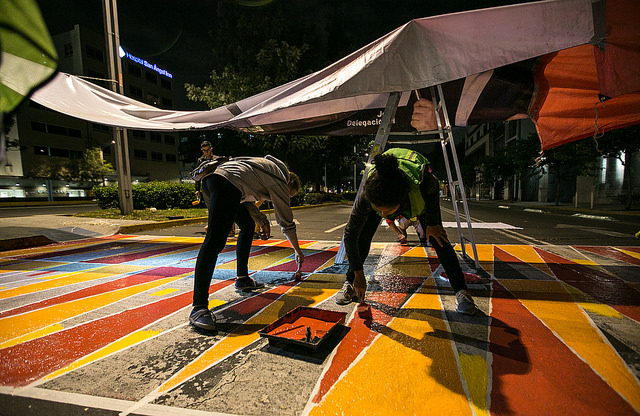
January 8, 2016
Q&A: Gabriella Gomez-Mount, Laboratorio Para la Ciudad (Part 1)
An interview with Gabriella Gomez-Mont, an artist, writer, documentarian, and curator who became the founder and director of a new government department centered around urban creativity and civic innovation in Mexico City, the Laboratorio Para la Ciudad
Gabriella Gómez-Mont speaks at the CDMX Digital Debate on Mexico city’s challenges and opportunities around technology and mobility.
Photo Credit: Laboratorio para la Ciudad
In 2013, writer, artist, documentarian, and curator Gabriella Gomez-Mont was presented with an intriguing thought experiment by Mexico City’s newly elected Mayor Miguel Angel Mancera—to imagine what a new government department centered around urban creativity and civic innovation could look like. Fast forward to 2016 and Gomez-Mont is halfway into her tenure as Founder and Director of Mexico City’s six-year grand experiment, the Laboratorio Para la Ciudad, Latin America’s first city office devoted to creatively connecting citizens and local government in order to research, imagine, and prototype new ways to address urban challenges and improve the quality of life for the world’s fifth largest city.
I recently got to meet with Gabriella in Mexico City to discuss the opportunities and challenges of designing a government department to serve the complex needs of a megalopolis as unique as Mexico City, a city that straddles both the developed and developing worlds with 22 million residents in the metropolitan area, half of which are under 26 and half of which are member’s of the city’s informal economy.
Rebecca Greenwald: How would you describe the Laboratorio and your role in it?
Gabriella Gomez-Mount: The Laboratorio Para la Ciudad is the experimental arm and creative think tank for the Mexico City government. What we do is four-fold. We research areas that might not necessarily be on the minds of other members of the local government—new types of themes and best practices, things that Mexico City could be doing differently, etc. We look at international best practices but also try to see what is going on at the local level. We start conversations between civil society and government, and in starting these conversations we have a whole myriad of different formats. The goal is to spur citywide conversations in order to create a common language and a common interest. Third, what we also do is prototype and pilot projects. We function as a good lab of sorts—we mitigate risk for the rest of government; we have the language and the context to try to experiment and be a little more bold in the type of things that government can try out because usually government is caught in a conundrum—on the one hand we expect it to be very solid and unchanging for obvious reasons, but on the other hand we sometimes are pained by the fact that government can lag ten or fifteen years behind the rest of civil society and academia. So our lab—along with the handful of other government labs that exist internationally—try to create that safe space to try out different things without risk. Last but not least, once these projects are proven successful, what we do is create a handover mechanism so that other ministries can adopt this model.

City residents ride along an elevated highway that the Laboratorio para la Ciudad and the Ministry of Environ-ment opened up pedestrians and cyclists in 2015.
Photo Credit: Laboratorio para la Ciudad
Going back to what I do with the Laboratorio, my role is to create relationships between different actors in Mexico City, bringing together people from both very high levels of government as well as the managers and members throughout civil society. In a certain sense my biggest role is to create a space where all these people can and will want to gather and talk about the potential and the challenges of Mexico City as well as figure out tangible new ways forward.
RG: You were tasked with literally building a government agency from scratch. How did you figure out how you wanted to build and structure it, and were there any other city governments, organizations, or institutions that you looked to as models in its creation?
GG-M: One of the things that I knew from the very beginning (especially because of what I used to do in my former life as an artist and community curator) was that I was very interested in experimenting with and researching what happens when you think about the creative ethos of the city, not only as pertaining just to the so-called creative class, but looking at creativity as a city resource and urban capacity in and of itself. The reason why I took this job is that government is an amazing space to be able to scale this idea. It’s more as a way of being for a city.
When I got the call from the recently elected new mayor’s office and they offered me free license to invent this government department from scratch, to be honest I was a little bit reluctant at first because I didn’t think that government necessarily was the place for me. I really wanted to create the lab, a space, and to be able to work with government but not necessarily to be within it. It was an amazing speculative exercise to think about what this could look like for the largest city on the Western Hemisphere and the city that I am madly in love with.
I started researching what was out there; what other entities and things were happening in other governments, and I came across several labs, one of which was Boston’s New Urban Mechanics, and obviously Mind Lab in Copenhagen which has been running for about 14 years, and Helsinki Design Lab which has since folded but was around and doing very interesting stuff. Those three were my primary inspiration; I was very heartened by the fact that there were these spaces for creativity and experimentation that were being born in other cities. I thought that that would be a very interesting model, taking into account that fortunately or unfortunately, there’s no way taking a model of any other city and trying to replicate it exactly in Mexico City because, as you can imagine, these cities are incredibly different than Mexico City.
So taking into account their experiences with all of them, we came up with this model for Mexico City, which tries to take best practices from each. But at the end of the day the hugest inspiration for the lab was Mexico City itself.

The holiday Park(ing) Day is a worldwide event where artists, designers, and citizens transform metered parking spots into temporary public parks. For 2015’s Park(ing) Day, Laboratorio para la Ciudad joined the community for the worldwide event.
Photo Credit: Laboratorio para la Ciudad
RG: Most of the 18 members of the department don’t have backgrounds in government. You’ve built a team of architects and designers, coders, historians, journalists, artists, filmmakers and urban psychologists. What has your experience been managing such an interdisciplinary team and directing their talents, both within the confines of local government and within such a complex set of issues?
GG-M: I’ve always worked in multidisciplinary environments, both now and in my former life. One of the questions that we’re continuously asking ourselves is, when you’re working with different disciplines, instead of watering down your language how do you actually create the opposite affect and allow for different topics and different mindsets to enrich a project and have it become incredibly layered? Since the beginning of the lab, we’ve been interested in working on systemic change, so thinking about the city as a network of systems and that instead of doing a handful of projects that are not necessarily interconnected, how do you start creating a strategy that works on different levels at once or sometimes in sequential order? And the multidisciplinary nature of the team is very interesting in that aspect.
With this diverse group of artists, designers, and filmmakers at the lab, one of the very first things we had to do was make the lab into a gathering space where people could come together to work on projects. The first thing that you have to design for and think about is how do you create this common watering hole where people want to come. In Latin America, there is a painful distrust of civil society through government so there are huge issues of trust, RGhence action. We’ve had this team involved from the very beginning in figuring out how the lab speaks and what it looks like and the type of issues we are getting ourselves into, and bringing in people who are specialized in different aspects of the city, for example I have an amazing expert in walkable cities at the lab.
There have also been growing pains because many times we’re used to coming at things from one angle or from one optic, one discipline, and right now we really have to sit with each other and figure out how we make a project substantial by adding in our different perspectives.

The “Cruce Seguro” (Safe crossing) intervention was aimed at creating a safer environment for pedestrians in an avenue known for being congested with vehicles.
Photo Credit: Laboratorio para la Ciudad
RG: What have been the biggest challenges and limitations of designing and executing this kind of program? The project has received a lot of praise and fascination, but I’m sure there are skeptics — what would they have to say and how would you address what their concerns?
GG-M: The biggest challenge has been how do you deal with excessive expectations of what 20 people embedded in government can do. We’ve had an amazing reaction from civil society in general since the lab started. This is both incredibly beautiful but also incredibly challenging because a city like this has so many issues that it needs to tackle, and 20 people cannot solve everything. The thing is that we don’t necessarily have the muscle to be able to react to anything and everything that the city needs to solve, and this is not that they’re not important subjects, but how do we start defining our territory of action?
Mexico City’s diversity is both its most valuable asset as well as its Achilles heel, which creates another challenge for us. I talk about diversity. First of all there’s the social diversity that this city houses both several billionaires, some of the richest men on the planet, as well as a population that has one of the lowest minimum wages in Latin America. This diversity is a huge asset, but it’s also very complex to be able to come up with solutions that make everybody happy. So how do you start prioritizing the things that you’re after, not forgetting that you have a very diverse society to cater to? How do you engage in conversations that make people feel that their voices are taken into account at the same time that you’re probably not going to get the outcome that you would have expected if it was only you or only a population that is very much like you and that has the same interests at heart? That’s certainly a challenge.
The third biggest challenge is administrative. Even though there’s been fantastic buy-in, including from the mayor and all of the city ministers, to be honest we have more projects that we’re offered than we know what to do with. There’s a lot of interest in working with the lab, and we cannot necessarily do everything that we wish we could do. That said, the way that the administration of government projects works is incredibly bureaucratic and that goes very much against the principles of agile, quick, and lean functioning, which is what we’re supposed to do. At the same time we’ve been giving birth to the projects of the lab, we’ve had to give birth to this very first grander experiment which is the lab in and of itself and how it works within government and how we can really make it function the best it can be. This has meant everything from bringing in external funding to figuring out how we can work with different partners, an example of which would be our ongoing partnership with MIT.
In part two of this interview, we’ll talk about how the department has deployed cross-sector, global partnerships to bring its projects to life, key lessons for other cities from the lab, and how to start thinking about defining urban innovation.–RG
Recent Viewpoints
Viewpoints
Navigating the Path to Net Zero





